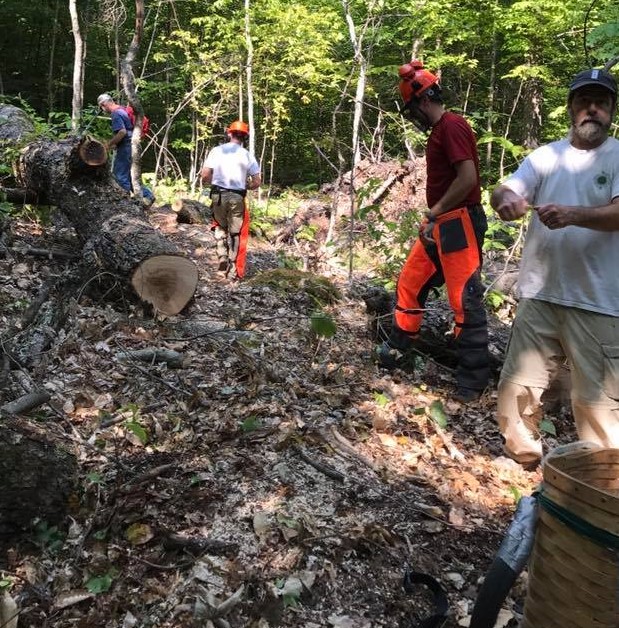September 14, 2017
Kirk and Cheryl St. Peter met Bill Duffy and Josh Bowe at Sandbank Stream Campsite in Katahdin Woods & Waters National Monument (KWW), reviewed and initialed the appropriate Job Hazard Analysis forms (JHAs) as part of a tailgate safety meeting, and completed other required National Park Service (NPS) paperwork, then headed out to the Wassataquoik ford. While Kirk, Bill & Josh crossed the ford and investigated a possible alternate route to get to Lunksoos Lean-to, Cheryl mineralized the area around the Wassataquoik Lean-to fire pit and photographed the log book entries. She then drove the loop road to the Barnard Mountain trailhead parking and worked at the Katahdin Brook Lean-to (mineralized around the fire pit, lopped brush around the site and up the trail to the privy and photographed log book entries).



After returning to Sandbank, it was determined that the alternate route explored today was not feasible and that we would all cross the ford tomorrow and clear the trail at least up to the old Fire Warden’s Cabin, leaving a chainsaw at the cabin for work on Saturday. Don Hudson and Cliff Young arrived to help with the work tomorrow.
September 15, 2017
After reviewing the appropriate JHAs during a tailgate safety meeting and signing/initialing NPS forms, all six workers (Kirk, Cheryl, Bill, Don, Josh, and Cliff) drove to the Wassataquoik trailhead parking, crossed the ford and cleared trail north to the Fire Warden’s Cabin, with Kirk and Josh leapfrogging each other and using chainsaws to clear the multiple blowdowns. Everyone else used loppers and/or handsaws to clear brush; a few tags were added. We stopped at the cabin for lunch and left the smaller chainsaw there for work tomorrow. A few older trees that could be stepped over were left due to the time.
After returning to Sandbank, we determined that Bill and Cliff would investigate an alternate route to Lunksoos Lean-to tomorrow by crossing the Wassataquoik where the IAT diverges from the trail to Orin Falls and then heading straight up past the east side of a pond to old logging roads, flagging the route if it appeared useable. Kirk and Josh would go the other way, following the IAT, while clearing blowdowns from the Fire Warden’s Cabin north. Cheryl and Richard Heath, who arrived that evening, would wait for Tom and Naomi Lynch (arriving in the morning) and do some additional work on the trail with loppers at least to the Fire Warden’s Cabin.
September 16, 2017
Kirk and Josh followed the IAT to the Fire Warden’s Cabin, where they picked up the chainsaw and cleared approximately a dozen blowdowns from there all the way north to Lunksoos Lean-to. Between the summit of Lunksoos and the lean-to, they met Bill and Cliff going the other way (they had stopped at the lean-to and mineralized around the fire pit). Kirk and Josh continued, following the alternate loop route that Bill and Cliff had flagged with orange flagging back to the Wassataquoik (potential trail name “Dave’s Cutoff” recommended by Earl Raymond due to his and Dave’s exploration of this route and all of Dave’s hard work on the trails). Bill and Cliff continued south on the IAT back to the trailhead. Cheryl, Richard, Tom and Naomi moved some posts with tags at the beaver dam crossing, then brushed the trail towards the Fire Warden’s Cabin. Since Naomi did not feel well, she and Tom turned back at the lookout and Cheryl and Richard continued to the cabin. Cheryl waited for Richard there as he continued to Deasey’s summit with loppers.

Notes:
The IAT from Wass. ford to Deasey’s Summit is in excellent condition, with a developing treadway and it is mostly clear of brush, with sufficient tags for a novice to follow. There are a few old blowdowns that can be stepped over. There are also two very active ground hornet’s nests: one along the Wass. north of the beaver dam crossing and one near the lookout.We left a post with tags at the first “beaver dam” post, which should be taken up to another turn where we determined that a post would be useful. There is a rusted and broken eye bolt on the NW corner of the Deasey Fire Cab that needs to be replaced. The IAT from Deasey’s Summit to Lunksoos Lean-to is free of blowdowns, but could definitely use significant additional brush clearing. A small shovel could be left at Lunksoos Lean-to for ease of mineralizing the fire pit. There is an approximately 11½ mile route that could be developed as a useable loop trail from the Wassataquoik trailhead following the IAT to Lunksoos Lean-to, continuing on an old logging road and an older trail (that would require additional investigation and clearing) to cross the Wassataquoik at the junction of the IAT and the Orin Falls trail, back to the trailhead.This route also allows for trail workers to continue working over Deasey and Lunksoos to the lean-to with an easier downhill route back.














